Share
How to Take the World’s Best Concert Photos
by Chris Owyoung The thought crossed my mind that all concert photography tutorials say the same damn thing: “use fast glass and shoot at a neces...
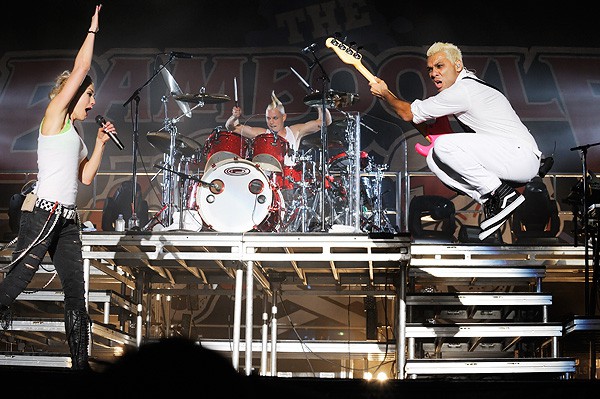
by Chris Owyoung
The thought crossed my mind that all concert photography tutorials say the same damn thing: “use fast glass and shoot at a necessarily high ISO. Good luck.” Since that’s about as useful as a hole in the head, I’ll skip the basics and write about some of the topics that matter most to the existing community of music photographers.
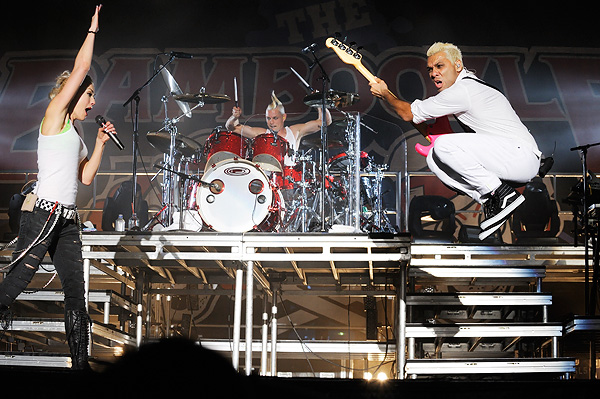
No Doubt performs at The Bamboozle Music Festival, their first major show in 5 years. East Rutherford, NJ. Photo by Chris Owyoung
The Basics (Only three sentences, I promise.)
If you own a digital SLR and a f/2.8 or faster lens, you can get by shooting a rock concert. If you’re comfortable working with RAW files and can shoot in manual mode chances are you’ll come away with some great images.
So, use fast glass and shoot at a necessarily high ISO. Oh and, good luck.
Equipment: Why does it matter? What do you use?
You needn’t look further than the early work of Jim Marshall or Bob Gruen to know that equipment does not matter. A camera is only as good as the photographer holding it and a bad photo taken with a $8,000 camera is still a bad photo.
Having better equipment only makes the work easier. The only critical reason to upgrade your gear is if your current equipment is preventing you from creating the kind of image you’re after. Your next “upgrade” could be a $15,000 digital back or a $5 disposable depending on your photographic vision.
All things being equal, photo editors do not care what equipment you use. You should consider the entire system of lenses, bodies and accessories offered by each company and choose a camera system that will grow with you.
I use the following questions to inform my own buying decisions:
Does the company make the equipment that I’ll need a year or two from now?
Can I easily rent the equipment I need but don’t own?
Is there a strong market for used equipment should I need to sell or upgrade again?
Should I upgrade now or wait a few months?
My current kit includes:
- Nikon D3 digital SLR
- Nikon 14-24mm f/2.8 lens
- Nikon 24-70mm f/2.8 lens
- Nikon 70-200mm f/2.8 lens
- Nikon 50mm f/1.8 lens
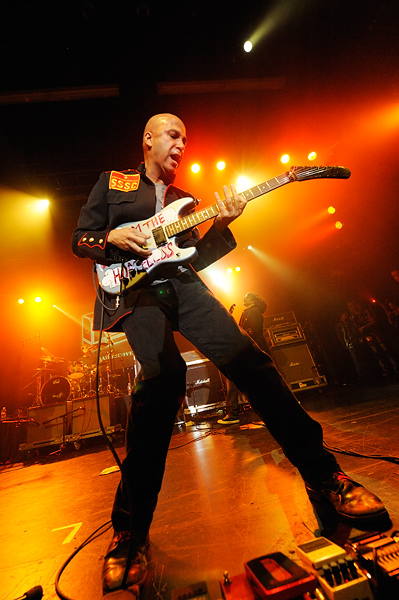
Tom Morello – Rage Against The Machine, Audioslave, Street Sweeper Social Club. Photo by Chris Owyoung
Rent what you Need:
If you have internet access and a mailing address, there’s no reason to ever go into a job without the proper equipment. With a day or two lead time, almost every lens or camera body from Nikon or Canon can be rented from reliable online rental companies like LensProToGo. Some lenses can be rented for as little as $15/day.
Getting Your First Photo Pass:
If you’re starting out like I did, your first photo pass probably won’t be All-Access for Aerosmith. My advice is to start local – take your camera to small, camera friendly venues and hone your skills. Once you’ve developed a photographic style and a set of good images, approach local publications with your work.
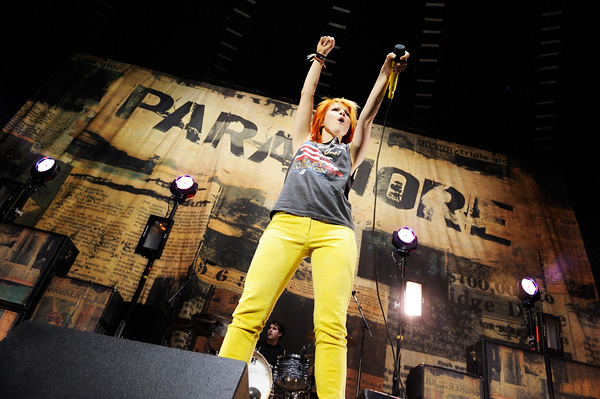
Hayley Williams – Paramore. Photo by Chris Owyoung
How do you find Publications/Assignments?
The easiest way to find publications to shoot for is to search the internet for concert reviews in your area. Once you have a list of magazines, newspapers and websites that are interested in concerts, assignments could be just an email or phone call away.
Above all, be persistent, polite and professional. Talent is important but it’s not a substitute for being reliable and a pleasure to work with.
How Do you Find Press Contacts:
If your editor doesn’t have the contact, your first stop should be the band’s websites (Facebook, Myspace, record label and management). Look for contact information for the press representative, or anyone associated with the label or management.
If no contact information is listed, a simple google search should lead you to an email address, mailing address or phone number to contact someone who can point you in the right direction. The “advanced search” link on Google (www.google.com) works wonders.
Useful search terms:
- artist name
- publicity
- pr
- client list
- tour dates
- record label name
- management name
Finally, don’t be afraid to pick up the phone and talk to people.
You mean I might have to actually speak? To strangers?
Yes. In addition, the first person you talk to probably won’t be the proper contact. It may take several calls to find the right person. Some people won’t have the time or inclination to help you. Become skilled at persuading them. Again, be sure to be persistent, polite and professional with everyone.
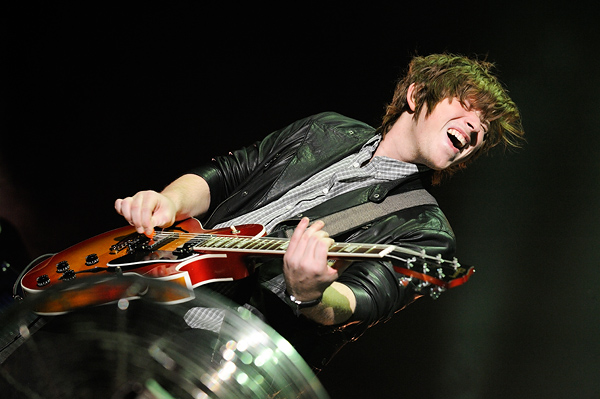
Matthew Followill – Kings of Leon. Photo by Chris Owyoung
How do you get noticed by magazines like Rolling Stone?
Pick up a copy of the magazine and find the mailing address (it’s in the masthead near the front). Send them a postcard with your contact information, website and your best image on it. Wait a few months/issues. Lather, rinse, repeat.
If you’re wondering what image to choose, imagine that you’re an Associate Photo Editor sitting in a sea of windowless grey cubicles. What kind of images would you decorate your office with?
It’s that easy?
Assuming they like your work, yes.
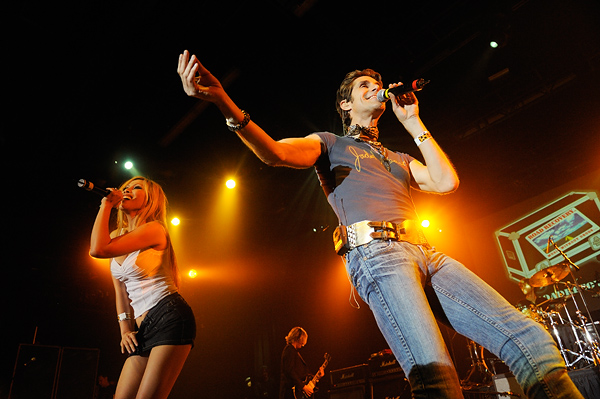
Perry Farrell – Jane’s Addiction, Porno for Pyros and Etty Lau Farrell. Photo by Chris Owyoung
How do you create iconic music images and still keep my editor and the publicist happy?
Sometimes my favorite images are not the ones that my editors end up running. The reasons for this are too many to mention here. The lesson is that it’s important to create a variety of images that fulfill the needs of your different viewers. Take photos for your editor. Take photos for the publicist. Take photos for the band, the fans and most importantly, take photos for yourself.
Critical Focusing: Beware the Microphone Stand
Getting acceptably in-focus photographs during an indie rock concert is difficult. Getting tack sharp photos during a metal show can be downright impossible. To be successful, you need to master the autofocus characteristics of your camera and lenses.
The lighting designs at concerts, which can be simultaneously elaborate and low light, wreak havoc on your camera’s ability to correctly judge focus. Autofocusing errors can lead to completely out of focus photos as well as instances when the camera focuses on something other than you intend (like a microphone stand or a guitar headstock).
Both kinds of focusing issues can be minimized with basic knowledge regarding how your camera decides what to focus on. Generally speaking, cameras focus on the area of highest contrast under the active autofocus point. What they don’t tell you in the manual is that the actual area covered by each of autofocus sensor is much larger than it appears in your viewfinder! Even if you have autofocus point directly over the eye of your subject, the camera may still focus on the mic stand if your subject is low in contrast.
To fix this:
- Don’t place the head of the microphone between you and your subject.
- Focus on a high contrast feature of your subject’s face such as the eyebrow or hairline.
- Use the center autofocus point of your camera (it’s the most accurate).
- Shoot from the side until the lighting on the subject improves.
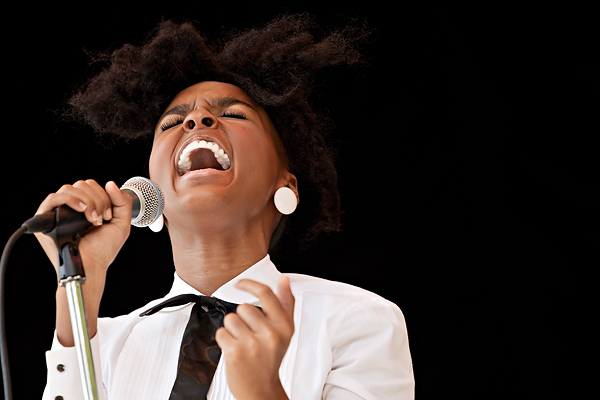
Janelle Monae. Photo by Chris Owyoung
Critical Framing: Why Composition Matters
Composition matters because, other than timing, it’s the only variable that can turn a technically sound snapshot into a jaw dropping rock photograph. Another concert photographer once said to me “you really concentrate on composition when you’re shooting” to which I replied “uhh, yeah…don’t you?”
On a basic level, I use composition to enhance the drama in my photographs. I include things that add to the image while minimizing or excluding distractions.
Some tips:
- Use the corners of the frame to emphasize your subject’s pose or gesture.
- Include outstretched arms, hands or other parts of your subject’s body that convey the emotion of the moment.
- Include the headstock of the guitar. (You want to sell the shot to the guitar company afterwards, right?)
- Exclude distracting elements like monitors or equipment stands if they don’t add to the composition.
- Include the lights if they add atmosphere to your composition.
- Include more than one band member in the photograph.
- If the artist has a large stage production, show it in your photos.
Why don’t you just shoot everything wide and decide how to crop the photo later?
I strive to get as close to the final product as possible every time I press the shutter. While I love what technology does for photographers, I want to spend as little time post processing as possible. Composing in-camera is part of this philosophy.
In addition to saving time in post, composing in-camera has the added benefit of maximizing the resolution of my final product.
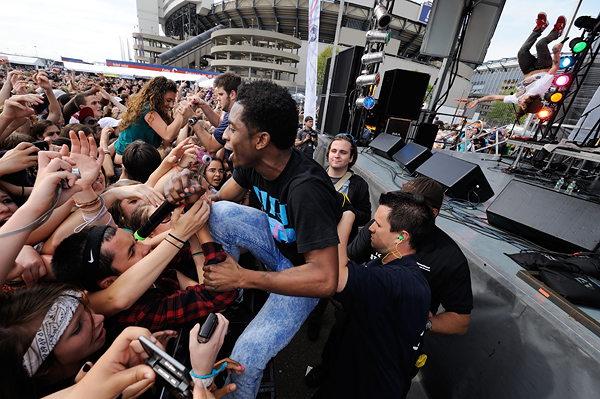 Shwayze and Cisco Adler. Photo by Chris Owyoung
Shwayze and Cisco Adler. Photo by Chris Owyoung
What to shoot: How to decide your next shot and where you need to be to get it.
The first three songs of a concert are a big guessing game. Making educated guesses based on your knowledge of the subject and your knowledge of the venue can mean the difference between a mediocre photo shoot and a fantastic one.
If you’re not familiar with either, knowledge of your subject and the venue can be gathered anywhere you can search for photos or videos. Media archives like YouTube, Flickr and Google Images are good places to start.
Recent photos and video can give you clues to the shooting conditions, lighting design and even the behavior of your subject during the allotted shooting time. Once armed with this information, you can go into your assignment with an idea of what photographs to take and where you need to be to take them.
Even if you go in with a well informed plan, it is extremely important to remain open minded and creative while shooting. Reducing the art of concert photography to a checklist of techniques and shots (like the ones in this article) will quickly leave you jaded and your work mediocre.
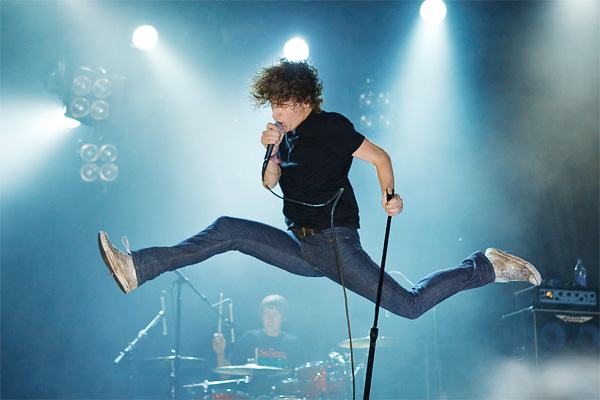 Matt Bowman – The Pigeon Detectives. Photo by Chris Owyoung
Matt Bowman – The Pigeon Detectives. Photo by Chris Owyoung
Taking the money shot or making the money shot?
A lot of the best photos in concert photography are made of the addicting combination of luck and skill that pit urchins like yours truly live and die for. The other 90% of rock photography consists of one part luck to five parts work.
As much as I would love every photo I take to spontaneously rock, I spend most of my shooting time visualizing the next photo and choosing the right settings and lens to create it. Since concert photography is naturally chaotic, the result of my process is often a series of photos with one image that illustrates my artistic vision better than the others.
Which one of this series of photographs would you choose? More importantly why is it better than the others? Asking and answering these questions of your own work will define your photographic style.
Examples – Images by Christopher Owyoung
White Balance: Help! my subject looks like a blueberry!
Technically speaking, the more accurate your white balance while shooting, the more accurate the RGB histogram will be on your camera’s rear LCD. The more accurate the RGB histogram, the easier it is to judge the proper exposure.
If the stage lighting is consistent but the camera’s auto white balance looks nothing like what’s in front of you, try a different white balance preset or dial in the kelvin temperature manually.
If the lighting is changing rapidly, do your best on auto and correct it in post. Assuming you’re shooting RAW, you can largely correct the white balance of your photos after the fact. That’s right, I said it – white balance can and should be adjusted in post!
Since adjusting the white balance in RAW changes the color of the entire image, it raises some complicated editorial issues. How much adjustment is too much? Is there such a thing?
Though I do not condone the practice, I often come across white balance options that look better than the lighting at actual concert. In my opinion, whether to use a white balance setting that is drastically different from reality depends first on how your photos will be used and second whether your artistic urges are stronger than your photojournalistic requirements.
Especially for large touring shows, consider that the band and their management would like your photos to look consistent with the design of the tour. Your photos may actually have less value to the people most capable of paying you if your white balance (or other editing) goes off the deep end.
On a more serious note, if you drastically alter the color (or content) of your photos, you must account for the journalistic standards of the assigning publication and the consequences to you and your publication if your work is determined to be overly edited.
Money, how I spend it and how I make it.
Every time you spend money on your business, you should be solving a problem. If you can’t create the kind of image you want, buy new gear. If you need to get your work seen by more people, invest in a website and a print mailing.
Unless you really like ramen, the editorial assignment rates for concerts aren’t solely enough to make a living on. No matter how talented you are, the value of a single concert photo to your publication isn’t high enough to justify the rates commanded by photographers working in other areas.
Other genres of photography command higher fees because their clients perceive more value in the work. Advertising photos sell product which makes money and builds the brand just as albums of wedding photos become family heirlooms that carry meaning for generations.
Fortunately, concert photography can have the same perceived value. The hard part is finding out who values your work and how much (in dollars) they value it over the work of your peers.
It’s very likely that 80% of your income will come from just 20% of your clients whether they be individual bands, record labels or corporate sponsors. Expect to earn a living by cultivating your relationship with your 20% instead of putting all your energy into selling prints to fans or licensing your images to magazines for $150 a placement.
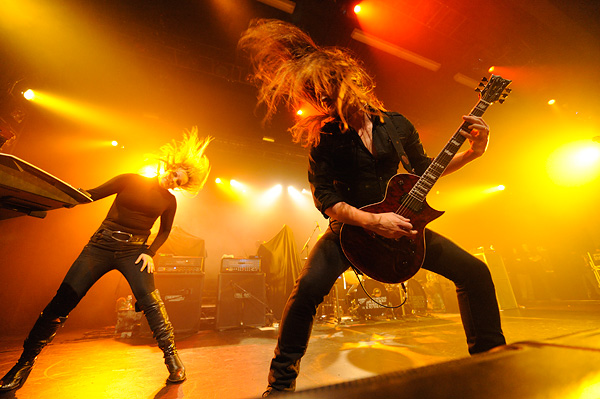
Satyricon. Photo by Chris Owyoung
Show Me The Money: Pricing Your Work for Assignment and Stock
While it’s nice to know what everyone else is charging, I find it more helpful to know how other photographers negotiate and how they estimate. Here is a bit about my own quoting process:
Stock Pricing – At the risk of sounding like a spokesperson for your next business expense, I’ll go ahead and say that quoting stock pricing couldn’t be easier thanks to Photoshelter.
If you’re not familiar with FotoQuote, it’s a piece of software that provides you with industry standard pricing data collected from stock agencies and other photographers. Why does this matter? Because Photoshelter has FotoQuote built in.
The process of pricing my stock photography is dead simple. Using Photoshelter’s web interface, I choose which licensing options to make available to my clients. An industry standard (average) price is magically generated for each option. After adjusting the prices to fit my business model, I simply apply the new pricing profile to photos in my archive.
What’s even better? Photoshelter’s implementation of FotoQuote gives me the unique ability to license my work without being tied to my desktop.
Example:
I was able to quote licensing for two images to a newspaper in Norway via my iPhone. Better yet, I did it while lying in bed. (There’s simply no down side to that!)
Assignment Pricing – If you’ve received an editorial assignment from an established print publication like Rolling Stone or even a new media publication like Metromix.com, chances are they’ve offered you a flat fee for a very specific job. Though there may be some room for negotiation based on quality of work or the circumstances of the assignment, you shouldn’t expect anyone to break the bank to hire you for editorial work. Print budgets are tighter than ever and in reality, the publication’s budget for your photos may be lower than your cost of doing business. Before declining outright, be sure to consider the potential value of the images to your archive as well as the value of the assignment to your relationships with all of the parties involved.
Negotiating Tips:
- Take the time to research the proper rates and provide your client with a professional quote.
- Ask tons of questions: What, where, how big, how-long and how many copies? You cannot provide an accurate quote without the answers.
- Don’t be bullied into agreeing to anything. No job is so urgent that you can’t call back in a few minutes.
- Always have two prices in mind. Your ideal price and your rock bottom price.
- Include additional rights or images before lowering the price.
- Never give away something without getting something in return.
- If something doesn’t feel right, ask other photographers for their opinions.
- If someone else is making money from your photos, you need to charge more. A lot more.
Everything else you need to know about pricing stock and assignment photography can be found in the following two books:
- Pricing Photography: The Complete Guide to Assignment & Stock Prices by Michal Heron and David MacTavish
- Best Business Practices for Photographers by John Harrington
Still Want More?
This article is heavy on process and light on technique. If you’d like to know more about the technical aspects of my work or any of the topics here, send your questions via the contact page on my website. I do my best to answer ever question I receive.
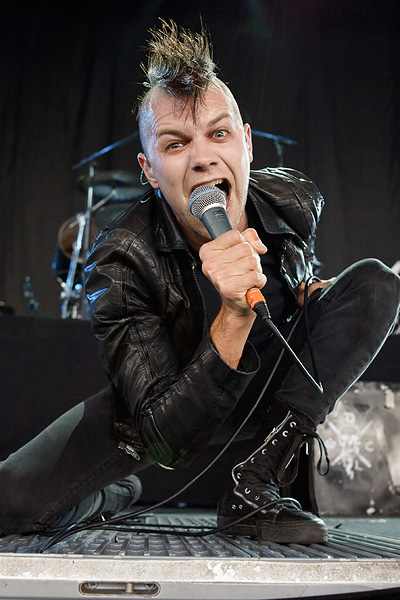
Bobby Alt – Street Drum Corps. Photo by Chris Owyoung
Chris Owyoung is a professional music photographer based in New York City. His portfolio includes members of The Metropolitan Opera alongside artists like Bruce Springsteen, Erykah Badu, The Cure and Kanye West. His work has appeared in Rolling Stone, Spin, Vibe, The New York Times, New York Magazine, The Village Voice and Billboard. Chris publishes detailed shooting notes for every concert he photographs and maintains an archive of Music Photography tips on his website.


